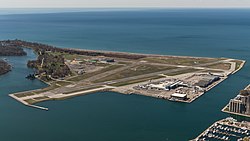Toronto Island Airport
|
Billy Bishop Toronto City Airport Toronto Island Airport |
|||||||||||||||
|---|---|---|---|---|---|---|---|---|---|---|---|---|---|---|---|
 |
|||||||||||||||
| Summary | |||||||||||||||
| Airport type | Public | ||||||||||||||
| Operator | PortsToronto | ||||||||||||||
| Serves | Toronto, Ontario | ||||||||||||||
| Location | Toronto Islands | ||||||||||||||
| Hub for | Porter Airlines | ||||||||||||||
| Time zone | EST (UTC−05:00) | ||||||||||||||
| • Summer (DST) | EDT (UTC−04:00) | ||||||||||||||
| Elevation AMSL | 252 ft / 77 m | ||||||||||||||
| Coordinates | 43°37′42″N 079°23′46″W / 43.62833°N 79.39611°WCoordinates: 43°37′42″N 079°23′46″W / 43.62833°N 79.39611°W | ||||||||||||||
| Website | Airport web site | ||||||||||||||
| Map | |||||||||||||||
| Location in Toronto | |||||||||||||||
| Runways | |||||||||||||||
|
|||||||||||||||
| Statistics (2012) | |||||||||||||||
|
|||||||||||||||
|
Sources: Canada Flight Supplement
Environment Canada Movements from Statistics Canada Passenger traffic from bloomberg.com |
|||||||||||||||
| Aircraft movements | 114,576 |
|---|---|
| Passenger Traffic | 2,300,000 |
Billy Bishop Toronto City Airport (IATA: YTZ, ICAO: CYTZ) is a small international airport located on the Toronto Islands in Toronto, Ontario, Canada. The airport is often referred to as the Toronto Island Airport and was previously known as Port George VI Island Airport and Toronto City Centre Airport; the latter is still found on legacy signs near the airport. The airport's name honours Billy Bishop, the Canadian World War I flying ace and Victoria Cross recipient and World War II Air Marshal. It is used by civil aviation, air ambulances, and regional airlines using turboprop planes. In 2015, it was ranked Canada's ninth-busiest airport and Ontario's third-busiest airport by passenger numbers and the sixth-busiest Canadian airport that serves the U.S.
Conceived in the 1930s as the main airport for Toronto, the construction of the airport was completed in 1939 by the Toronto Harbour Commission (THC). At the same time, the THC built Malton Airport as an alternate, but Malton (today Toronto Pearson International Airport) became Toronto's main passenger airline hub instead, leaving the island airport for general aviation and military purposes. During the 1940s and 1950s, several political leaders proposed an expansion of the island airport to enable scheduled passenger airlines and reduce the annual operating costs. Malton was sold in 1962 to the Government of Canada in exchange for an expansion and improvements to the island airport. After the expansion, civil flights increased to a peak of over 200,000 annual flights in the 1960s. Although regional airlines were introduced in the 1970s, the annual number of flights went into decline and closure was discussed. In 1983, a 50-year tripartite agreement between the governments of Canada, City of Toronto and the Harbour Commission, which limited noise and banned jet use for scheduled airlines, allowed airport operations to continue. In the 1990s, in an era of government cost-cutting, questions about the airport's future were raised again due to its annual deficit. At the same time, redevelopment was taking over north of the airport and several studies suggested that the airport was incompatible with development.
...
Wikipedia



